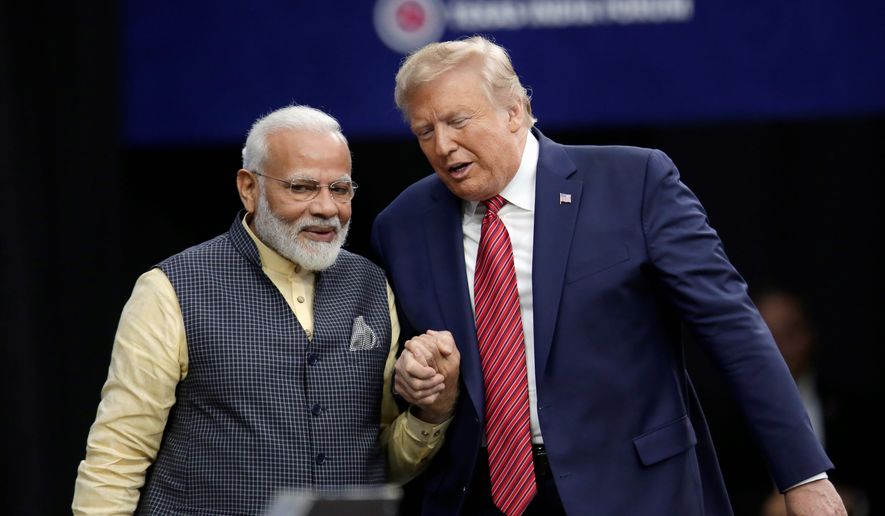The leaders of the world’s two biggest democracies will meet Monday and Tuesday when President Trump visits Indian Prime Minister Narendra Modi.
Aparna Pande, director of the Hudson Institute’s Initiative on the Future of India and South Asia, sat down with The Washington Times’ Madison Hirneisen to discuss what to expect from the visit.
Question: Talk about the state of U.S.-Indian trade relations. How likely is it that a trade agreement will be reached as a result of this trip?
Answer: A trade agreement would be good if it comes through. However, I am not sure a trade agreement, even a mini-trade agreement, will happen during this trip. President Trump himself said [this week] that he doesn’t think a trade deal will come through right now, but he says a trade deal with India will [be reached] either before or after the elections in the U.S. And there’s a reason for that: Right now, you have populist, nationalist and semi-protectionist administrations on both sides. … The president and the prime minister would need to appease their base, and for their base they need to show that they have not given in to the other side. So the issues which are easy to resolve have always been easy to resolve. The problem always comes down to things like pharmaceuticals. India has a big generic industry, [and] India has a very large number of people below the poverty line, [so] they like to keep pharmaceuticals very low priced so that they can cater to their constituencies. The pharmaceutical companies in the U.S. do not like it.
Q: Prime Minister Modi has faced criticism at home for a new law that critics say discriminates against Muslims. Will this be an issue that affects Mr. Trump’s trip?
A: I would sort of separate it into sides. On the one hand, this is going to be a visit that is going to be high on show and splendor. It’s going to look really good; the optics will be wonderful. The Indian government is planning a lot. There’s going to be a couple hundreds of thousands of people all lining the streets from the airport to the stadium where [there] will be a comparable rally to the “Howdy Modi,” but it will be “Welcome Trump.” President Trump is going to go to Agra, [and] there’s going to be a lot of optics. And so Prime Minister Modi will be able to demonstrate and tell the Indian people, ’See, the president did come to India.’ … [But] I also believe it will not take away from what is happening inside India. And the world sort of expects India to do better. What is happening with respect to Kashmir or the [citizenship law] does not take away from the strategic relationship. That is strong, and it will remain strong.
Q: What would be the best possible outcome of the president’s visit? What could go wrong?
A: I can answer the second one a lot faster. India is hoping — and I’m sure a number of U.S. administration officials are hoping — that President Trump does not mention Kashmir or the offer to negotiate in Kashmir, which he has done over the last six months. He has offered to mediate between India and Pakistan, and India has always pushed back and said no. India sees [the status of disputed Kashmir] as a bilateral issue with Pakistan and nobody else should come in the middle. … On the positive side, I do believe that President Trump’s visit itself is big for India. He is the fourth American president in a row going to [India]. Presidential visits are good because what they do is ensure that the U.S. delegation is going to be at the Cabinet level with the president. So there will be discussions — you know [if] there’s a deal or a negotiation, not necessarily on trade, [but] on the defense side, counterterrorism, China, all the other discussions. It is much easier to get them to fruition when the president is going because then the national security advisers can meet.
Q: The Trump administration hopes to sign a peace deal with the Taliban in Afghanistan, perhaps while Mr. Trump is traveling. What effect would a deal have on India?
A: Big, big, big [effect]. India is the largest regional bilateral donor to Afghanistan. We give about $2 billion in developmental assistance to Afghanistan. Roads, highways, dams, the parliament building [and] a number of schools come from Indian developmental assistance. So for India, a stable, peaceful, non-Taliban-run Afghanistan is the ideal. … India does not see the deal as a peace deal [but] as basically handing Afghanistan to the Taliban on a platter and a withdrawal deal from the U.S. point of view. The U.S. wants to get out [while] India would much rather [prefer] that the Afghans be allowed to decide. [If] the Afghan government talks to the Taliban, India will support the Afghan government. But it’s the Afghan government’s decision to make.




Please read our comment policy before commenting.